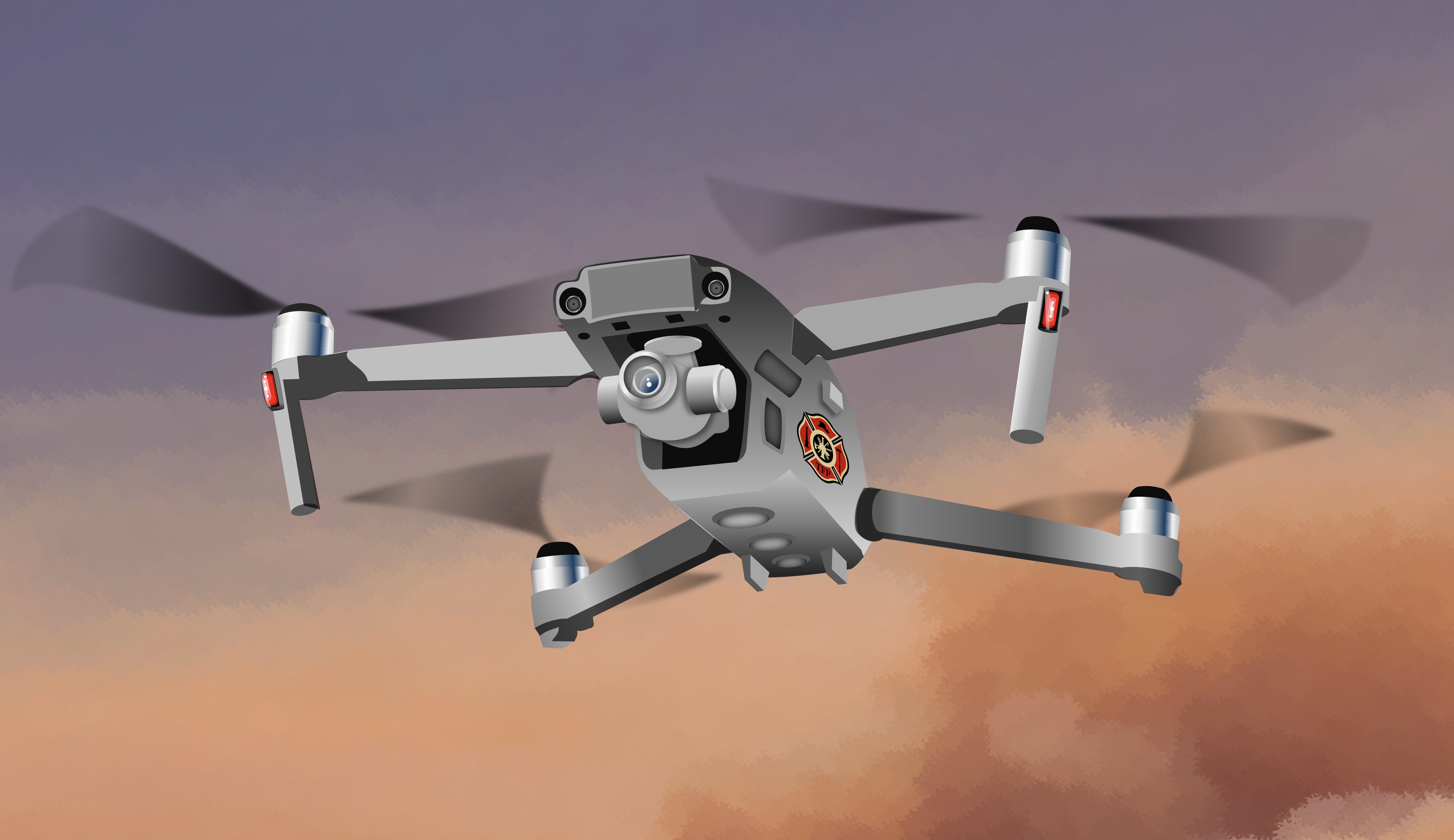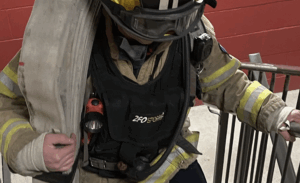In the ever-evolving landscape of firefighting, innovation stands as a beacon of hope amidst the worldwide chaos and challenges firefighters face. One such innovation that has revolutionized firefighting operations is the integration of firefighter drones. These unmanned aerial vehicles (UAVs) have emerged as invaluable tools, reshaping how firefighters combat blazes and protect communities.
The role of drones in modern firefighting
Firefighting drones play multifaceted roles in modern firefighting, serving as eyes in the sky, swift responders, and invaluable assistants to firefighting teams on the ground. From aerial surveillance and situational awareness to thermal assessment and search and rescue operations, drones have proven their worth time and again in the face of adversity.
Beyond their operational functions, the integration of drones in firefighting underscores a fundamental shift towards embracing technology for enhanced effectiveness and efficiency. As firefighting agencies grapple with increasingly complex challenges such as urbanization, climate change-induced wildfires, and limited resources, leveraging technological advancements cannot be overstated.
Importance of utilizing technology
Drones represent a paradigm shift in firefighting tactics, offering unprecedented capabilities once confined to imagination. By embracing these cutting-edge tools, firefighting agencies can navigate hazardous environments with greater precision, respond to emergencies more swiftly, and ultimately save lives and safeguard communities more effectively.
In this blog article, we delve into the transformative role of drones in modern firefighting, exploring their varied applications and highlighting their pivotal role in advancing firefighting operations. Join us as we embark on a journey to uncover the potential of firefighting drones and redefine the future of firefighting.
Top 10 Reasons Fire Departments Use Drones
Fire departments utilize drones for various purposes, including forest firefighting, structural firefighting, search and rescue, and responding to natural disasters.
Here are some common reasons why a fire department would be interested in using drones:
1. Aerial Reconnaissance:
Drones provide real-time aerial footage, allowing firefighters to assess the extent and spread of wildfires, monitor structural fires, and identify potential hazards from a safe distance.
2. Situational Awareness:
Drones equipped with thermal imaging cameras can detect hotspots, trapped individuals, and structural weaknesses, enhancing firefighters’ situational awareness on the ground.
3. Mapping and Planning:
Drones can create detailed maps of fire-affected areas, helping firefighters plan evacuation routes, deploy resources strategically, and prioritize areas for containment efforts.
4. Accessing Hard-to-Reach Areas:
Drones can access areas inaccessible to traditional firefighting equipment, such as rugged terrain, dense forests, and hazardous environments, improving overall response effectiveness.
5. Monitoring Fire Behavior:
Drones equipped with specialized sensors can monitor fire behavior, including temperature changes, wind patterns, and smoke dispersion, aiding in fire prediction and control.
6. Search and Rescue Operations:
Drones equipped with high-resolution cameras and thermal imaging technology can assist in locating missing persons, especially in challenging environments such as dense forests, rubble piles, or during nighttime operations.
As a State Urban Search and Rescue (SUSAR) worker, I’ve found drones invaluable for wide-area searches. Drones have revolutionized our search and rescue operations, making them more efficient and effective in bringing people to safety.
7. Communication Relay:
Drones equipped with communication relays can extend radio coverage in remote areas or areas with poor reception, facilitating communication between firefighters and command centers.
8. Damage Assessment:
Drones can conduct rapid damage assessments after natural disasters such as earthquakes, hurricanes, or floods, providing critical information for planning recovery and response efforts.
9. Hazmat Incident Monitoring:
Drones equipped with gas sensors and environmental monitoring equipment can assess hazardous material incidents, identify chemical leaks, and evaluate air quality in affected areas.
10. Training and Simulation:
Fire departments can use drones to train, simulate emergency scenarios, practice aerial operations, and familiarize personnel with drone deployment protocols.
Top 10 Drone Features Fire Departments Look For
Fire departments typically look for drones with specific features that cater to their operational needs and enhance their capabilities in emergency response scenarios. Here are some main features that a fire service would be interested in when selecting a drone:
1. Durability and Reliability:
Fire departments need drones that can withstand harsh environmental conditions, including high temperatures, strong winds, and exposure to smoke and debris. Drones with rugged construction and reliable components are essential for long-term use in demanding situations.
2. Long Battery Life and Extended Flight Time:
Drones with extended flight times allow firefighters to conduct prolonged aerial surveillance and monitoring without frequent battery changes or recharging. Longer flight times enhance operational efficiency and provide more excellent coverage during emergencies.
3. High-Resolution Cameras:
Fire departments require drones with high-resolution cameras capable of capturing detailed aerial imagery and video footage. High-quality imagery helps firefighters assess the situation accurately, identify hazards, and plan effective response strategies.
4. Thermal Imaging Capability:
Thermal imaging cameras on drones enable firefighters to detect heat signatures, hotspots, and individuals in smoke-filled environments or during nighttime operations. Thermal imaging enhances situational awareness and aids in locating victims and assessing fire behavior.
5. Real-Time Video Transmission:
Drones equipped with real-time video transmission capabilities allow firefighters to stream live footage to incident commanders and personnel on the ground. Real-time video feeds provide crucial situational updates, enabling timely decision-making and coordination of response efforts.
6. GPS and Autonomous Flight Features:
GPS-enabled drones with autonomous flight capabilities offer precise navigation and waypoint-based missions, allowing firefighters to conduct systematic aerial surveys and mapping operations. Autonomous flight features reduce pilot workload and ensure accurate data collection during missions.
7. Obstacle Avoidance and Collision Detection:
Drones with obstacle avoidance sensors and collision detection systems can navigate safely in complex environments and avoid obstacles such as trees, buildings, and power lines. These features minimize the risk of mid-air collisions and ensure the safety of both the drone and personnel on the ground.
8. Compact and Portable Design:
Compact and portable drones are easy to transport to the incident site and deploy quickly, minimizing response times and maximizing operational flexibility. Lightweight drones with foldable or modular designs are ideal for storage in fire trucks or emergency vehicles.
9. Integration with GIS and Mapping Software:
Drones integrating Geographic Information Systems (GIS) and mapping software enable firefighters to overlay aerial imagery with geographic data, such as topography, infrastructure, and hazard zones. GIS integration enhances situational awareness and supports data-driven decision-making during emergencies.
10. Interoperability with Command-and-Control Systems:
Drones that integrate with existing command and control systems used by fire departments facilitate seamless communication, data sharing, and coordination of aerial operations with ground-based personnel and incident commanders.
By prioritizing these features, fire departments can select drones that enhance their operational capabilities, improve situational awareness, and facilitate effective response to emergencies such as wildfires, structural fires, search and rescue missions, and natural disasters.
Firefighting Drones
The Top Drones for Firefighting Search and Rescue
Updated With New Drone Models for 2024
Note: Fly safely and responsibly, folks. Never flown before? Learn about drone regulations, certifications, and licenses here. Need to get your FAA (Part 107) commercial drone certificate? Start studying here.
A commercial UAV pilot is only as good as the equipment they use.
So today, I’m going to show you the top professional drones that serious pilots should consider.
There are so many options out there, so it can be easy to get bogged down. The multirotors we’ve chosen were manufactured by one of the best and most reliable brands, Autel Robotics.
Autel Robotics stands at the forefront of this technological revolution, offering state-of-the-art thermal imaging drones explicitly designed for the rigors of firefighting operations.
Autel Robotics has established itself as a leader in unmanned aerial vehicles (UAVs), leveraging its expertise to develop drones tailored to the unique needs of firefighters.
Their commitment to innovation, reliability, and user-centric design has made them a trusted partner for fire departments worldwide.
I also listed the other top 5 brands in aerial technology for firefighting later in this article.
The Best Firefighting Drones Have Advanced Thermal Imaging
Top Fire Department Drone Picks
EVO Max 4N

Camera: 50MP | 1/1.28″ CMOS | Thermal: 640×512 | 16x Digital Zoom | Starlight Night-Vision | Lock Targets & Track at Night
Flight Time: 42 Minutes | $12,599
EVO Max 4T

Camera: 50MP | 1/1.28″ CMOS | Thermal: 640×512 | 16x Digital Zoom | Laser Rangefinder | 720° Obstacle Avoidance
Flight Time: 42 Minutes | $8999
EVO II Dual 640T RTK V3

Camera: 50MP Picture | 0.8″ CMOS Sensor | Thermal: 640×512 | 15km Image Transmission | 360° Obstacle Avoidance
Flight Time: 38 Minutes | $5799
EVO II Dual 640T V3

Camera: 50MP Picture | 0.8″ CMOS Sensor | Thermal: 640×512 | 15km Image Transmission | 360° Obstacle Avoidance | Note: It cannot be equipped with RTK modules accessories
Flight Time: 38 Minutes | $4799
Compact Non-Thermal Drone Picks
EVO Lite Drone

Camera: 6K Video & 20MP Photo | 1-Inch CMOS Sensor | 12km Video Transmission | Obstacle Sensing in 3 Directions
Flight Time: 40 Minutes | $1399
EVO Nano Drone

Camera: 1/1.28 Inch CMOS Sensor | 10km Video Transmission | Dynamic Track 2.1 | Obstacle Sensing in 3 Directions | Level 5 Wind Resistance | 249g Aircraft Weight
Flight Time: 28 Minutes | $679
A Little About Autel Robotics
Innovative Technology
Autel Robotics’s advanced thermal imaging technology is at the heart of its offerings. Equipped with high-resolution thermal sensors, its drones provide firefighters with real-time aerial views of the scene, even in low-visibility conditions such as dense smoke or darkness. This invaluable capability enables firefighters to quickly identify hotspots, locate trapped individuals, and assess the extent of the fire, all from a safe distance.
Autel’s thermal imaging drones boast impressive features, including customizable temperature color palettes, adjustable temperature measurement scales, and precise temperature readouts. These capabilities empower firefighters to make informed decisions on resource allocation, strategy planning, and victim rescue, enhancing their operations’ safety and effectiveness.
Robust Design
Recognizing the demanding nature of firefighting environments, Autel Robotics has engineered their drones to withstand the harshest conditions. Built with durable materials and reinforced structures, these drones can endure extreme temperatures, high winds, and heavy smoke without compromising performance.
Moreover, Autel’s drones are equipped with advanced obstacle avoidance systems and intelligent flight modes, ensuring smooth and reliable operation even in challenging terrain or confined spaces. This robust design not only enhances the drones’ durability but also minimizes the risk of accidents or malfunctions during critical missions.
User-Friendly Interface
In addition to their technical prowess, Autel Robotics prioritizes user experience, designing their drones with intuitive interfaces and streamlined controls. Firefighters can easily pilot the drones using Autel’s dedicated mobile app, which offers comprehensive flight planning tools, live telemetry data, and remote camera controls.
Furthermore, Autel provides extensive training and support services to fire departments, ensuring that personnel are proficient in operating the drones effectively. From basic flight maneuvers to advanced thermal imaging techniques, Autel equips firefighters with the knowledge and skills they need to leverage the full potential of their drones in the field.
Mission-Critical Applications
The applications of Autel Robotics’ thermal imaging drones in firefighting are diverse and far-reaching. Whether combating wildfires, conducting search and rescue missions, or inspecting hazardous structures, these drones are invaluable tools for enhancing situational awareness and optimizing resource allocation.
During wildfire suppression efforts, Autel’s drones enable firefighters to monitor fire behavior, identify hotspots, and assess the effectiveness of containment lines in real-time. This proactive approach improves operational efficiency and minimizes the risk to personnel and surrounding communities.
In urban firefighting scenarios, Autel’s drones provide crucial support in locating and rescuing trapped individuals, detecting hidden fire sources, and assessing structural integrity. By augmenting traditional firefighting techniques with aerial thermal imaging, firefighters can mitigate risks more effectively and save lives.
Autel Robotics stands as a beacon of innovation in the firefighting industry, pioneering the integration of thermal imaging technology with unmanned aerial vehicles to revolutionize emergency response operations. With their unwavering commitment to excellence, reliability, and user satisfaction, Autel continues to empower firefighters worldwide with the tools they need to combat fires more effectively and protect their communities with unparalleled precision and efficiency.
Top 5 Firefighter Drone Manufacturers
While this article only highlights Autel Robotics and its pioneering drones, I also want to acknowledge the prominence of other top brands in aerial technology for firefighting.
Drones play a pivotal role in modern firefighting, offering crucial aerial insights for emergency responders.
Here are the top five manufacturers catering to fire services:
- Autel Robotics: Autel’s EVO II series boasts thermal imaging and 8K cameras, delivering actionable intelligence for effective emergency response.
- DJI: Known for reliability and versatility, DJI’s drones like the Matrice series and Mavic 2 Enterprise Dual feature thermal imaging for hotspot detection and victim location.
- FLIR Systems: Renowned for thermal imaging, FLIR’s drones such as the K33 and MUVE C360 provide enhanced visibility through smoke and darkness.
- Parrot: Parrot’s ANAFI USA offers compact design and thermal imaging, empowering firefighters with situational awareness in challenging environments.
- Yuneec International: Yuneec’s Typhoon H3 and H520E RTK feature precise navigation and high-performance cameras for accurate aerial inspections.
These manufacturers provide firefighters with essential tools, enhancing operational capabilities and ensuring safer communities through efficient emergency response strategies.
Navigating Drone Regulations, Certifications and Licenses
A Guide to Operating Drones in the United States
In recent years, the use of drones has skyrocketed across various industries, from aerial photography and videography to agriculture, construction, and public safety. However, with the increasing integration of drones into the national airspace, regulations and certifications have become essential for ensuring safe and responsible drone operations. In this article, we’ll explore the certifications and licenses required to operate drones in certain areas in the United States, including state-specific regulations.
Federal Aviation Administration (FAA) Regulations
The Federal Aviation Administration (FAA) is the governing body responsible for regulating the use of drones in the United States airspace. The FAA has established specific rules and requirements for operating drones, including the following key regulations:
1. Remote Pilot Certificate (Part 107)
To operate a drone commercially or for any non-recreational purpose, individuals must obtain a Remote Pilot Certificate under Part 107 of the FAA regulations. To qualify for the Part 107 exam, applicants must be at least 16 years old, pass an aeronautical knowledge test, and undergo a background check.
Need to get your FAA (Part 107) commercial drone certificate? Studying made easy here.
Pilot Institute’s Part 107 Commercial Drone License Course has a proven track record of success, with a 99% pass rate and over 70,000 students signing up for the course. One of the biggest selling points of this course is its affordability.
2. Recreational Drone Flying (Community-Based Organizations)
Recreational drone pilots who fly for hobby or recreation purposes can operate under the guidelines provided by community-based organizations (CBOs) such as the Academy of Model Aeronautics (AMA) or the Recreational UAS Safety Test (TRUST). These guidelines include restrictions on altitude, proximity to airports, and flying within a visual line of sight.
If you fly your drone recreationally under the Exception for Recreational Flyers, you must pass the test before you fly.
Need your recreational drone certification? Get certified here in three easy steps.
3. Drone Registration
All drones weighing between 0.55 and 55 pounds must be registered with the FAA. Registered drones receive a unique registration number that must be affixed to the aircraft for identification.
Need to register your drone? Learn how to register your drone here.
State-Specific Regulations
In addition to federal regulations, some states have implemented their laws and regulations governing drone operations. These state-specific regulations may include additional licensing requirements, operational restrictions, and privacy considerations. Here are a few examples of state drone regulations:
1. California:
California has enacted legislation addressing privacy concerns related to drone use. Additionally, certain cities and municipalities within the state may have ordinances regulating drone operations in public spaces.
2. Texas:
Texas prohibits using drones to capture images of individuals or property without consent in certain circumstances. The state also imposes restrictions on drone operations near critical infrastructure and correctional facilities.
3. New York:
New York has implemented laws prohibiting using drones near airports, correctional facilities, and other sensitive locations. The state also requires commercial drone operators to obtain a permit for certain operations.
4. Florida:
Florida has regulations governing drone operations near critical infrastructure, emergency response operations, and law enforcement activities. The state also prohibits using drones for harassment or surveillance without consent.
Importance of Compliance with Federal Laws
Navigating the complex landscape of drone regulations and certifications can be daunting, but it’s essential for ensuring safe and legal drone operations.
By obtaining the necessary certifications and adhering to federal and state regulations, drone operators can enjoy the benefits of drone technology while minimizing risks to public safety and privacy.
Whether flying for recreational or commercial purposes, staying informed about the latest regulations is crucial for responsible drone piloting in the United States.
Failure to comply with federal laws can also result in fines, penalties, or legal consequences, highlighting the importance of understanding and adhering to these regulations.
FAQ: Firefighting Drones
Q: What types of drones do firefighters use?
A: Firefighters utilize a range of drones equipped with thermal imaging, visible light, and multispectral cameras. These drones vary in features such as flight duration, autonomy, and environmental resilience. Firefighting drones must be waterproof, dustproof, and capable of operating in harsh weather conditions.
Q: Which drone is most suitable for emergency services?
A: Drones employed in emergency services must be highly responsive, precise, and adaptable. Drones with different camera types, sensors, and flight modes can fulfill diverse operational requirements. Some drones offer autonomous flight capabilities for rapid emergency response, while others boast extended flight times to provide prolonged real-time support.
Q: How are fire departments utilizing drones for firefighting and rescue missions?
A: Fire departments are increasingly integrating drones into firefighting and rescue operations. Drones offer invaluable real-time imagery and data, enhancing firefighters’ situational awareness and aiding fire source identification. Moreover, drones play a crucial role in search and rescue efforts by providing vital information and facilitating swift decision-making.
Q: What is the cost range of firefighting drones?
A: The price of firefighting drones varies depending on their specifications and configurations. Prices can range from several thousand dollars to tens of thousands of dollars. Fire departments can select drones that align with their budget and operational requirements. Additionally, advancements in drone technology may lead to future price reductions.
Q: What safety measures are in place to prevent drone-related incidents during firefighting operations?
A: Fire departments implement strict safety protocols to mitigate the risk of drone-related incidents during firefighting operations. These measures include thorough training for drone operators, adherence to airspace regulations, coordination with aviation authorities, and comprehensive risk assessments before drone deployment.
Q: Can drones be used to assist in hazardous material incidents?
A: Drones with specialized sensors and cameras can be crucial in hazardous material (HazMat) incidents. These drones can assess the extent of chemical spills, monitor air quality, and provide valuable data to emergency responders, enabling them to plan and execute effective mitigation strategies while minimizing exposure risks.
Q: How do drones contribute to post-fire assessment and analysis?
A: Drones facilitate post-fire assessment and analysis by capturing high-resolution aerial imagery of fire-damaged areas. This imagery enables fire investigators and insurance professionals to analyze the extent of damage, identify potential causes, and assess the structural integrity of affected properties. Additionally, drones aid in documenting the aftermath of wildfires for recovery and mitigation efforts.
In conclusion
Integrating drones into modern firefighting operations offers invaluable benefits to fire departments worldwide. From enhanced situational awareness to efficient incident assessment, drones provide indispensable support in challenging emergency scenarios.
Fire departments prioritize drone features like thermal imaging, durability, and ease of operation. Top manufacturers such as DJI, FLIR Systems, Parrot, Yuneec International, and Autel Robotics are leading the charge in innovation.
Navigating drone certifications and licenses is essential for legal compliance and operational safety, while comprehensive guides and FAQs aid in understanding regulations and best practices for operating drones in the United States.
As fire services continue to embrace drone technology, the collaborative efforts between manufacturers, regulators, and firefighters ensure the continual advancement of aerial tools in safeguarding communities and saving lives.
Become A Career Firefighter

Mastering the Firefighter Exam is a complete guide on how to pass the firefighter exam with a top score. It simplifies the complicated hiring practices of big city fire departments and reveals insider information most candidates don’t know about.
If You Would Like To Know How To Get A Head Of Your Competition, This Book Is For You.







